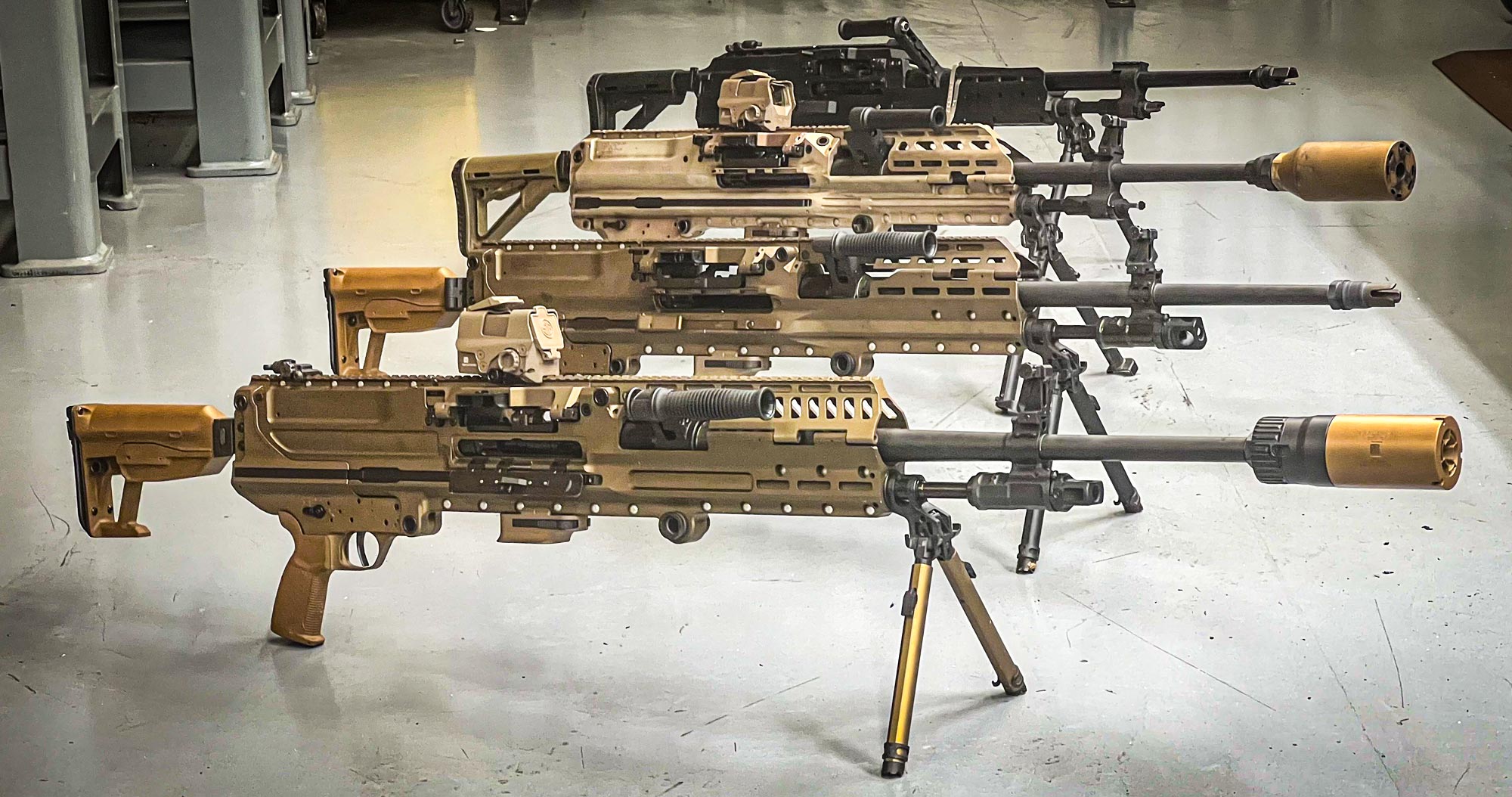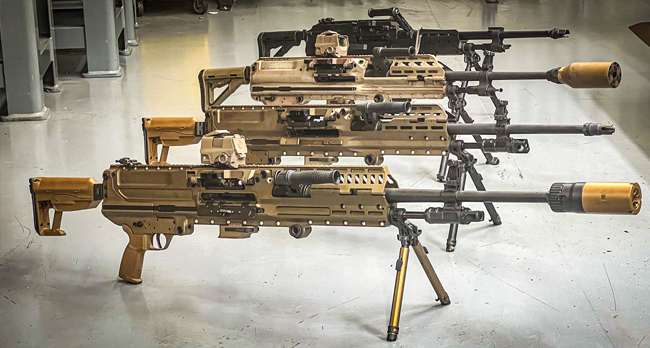The Objective: The SIG-MMG 338 Program - Tested and Delivered (Part 2)
This is the second installment of a two-part series that details the journey of SIG SAUER’s machine gun development effort that began with the SIG MMG 338 for U.S. SOCOM’s LMG-M program, transitioned to the U.S. Army’s Next Generation Squad Weapons program, and is now returning to its roots. Read Part 1 here.
Partnered Content by Rob Curtis/RECOIL Magazine
SIG SAUER was now working on two machine gun programs at once. The majority of its machine gun development effort was temporarily shifted from its work on the SIG-Medium Machine Gun 338 (SIG-MMG 338), a lightweight 338 Norma Magnum-chambered medium machine gun for U.S. SOCOM, and was now directed toward the U.S. Army’s Next Generation Squad Weapon (NGSW) XM250 light machine gun program. While this slowed development of the large caliber machine gun, the decision to split the effort would pay dividends later, as lessons learned while working on the light machine gun would later be applied to the medium machine gun.
Now working on the second-generation prototype, SIG’s engineers put significant effort into SOCOM’s caliber conversion capability requirement. The command required its lightweight medium machine gun (LWMMG) to run 7.62 NATO ammo in addition to 338 NM for both operational use and as a low-cost training option. While it seems counterintuitive, running the large caliber machine gun operating system with a smaller cartridge is actually harder on the system and produces more wear. This presented a difficult engineering problem for SIG’s engineers to overcome, and we’ll discuss this issue, and more, in an upcoming post on "The Objective" detailing the technical development of the SIG-MMG 338.
The (roughly) year of work by the SIG-MMG 338 team resulted in an improved, second-generation (Gen2) prototype that was finished in early 2019. At 23 pounds, it weighed slightly less than its Gen1 predecessor, and, just as important, its operational reliability jumped up to 300-450 MRBS after incorporating lessons learned from the company’s work on the SIG-LMG 6.8 program.
Crucially, in 2019, the company’s initial gamble to embark on SOCOM’s LWMMG project showed some real promise. That was when the command held a vendor range day and assessed three competing lightweight medium machine gun submissions from three vendors. After evaluating each offering, SOCOM bought 10 of SIG’s second-generation SIG-MMG 338s. The command would use these to develop its capability and performance requirements for the LWMMG program. Before it was put to use by SOCOM, though, the Gen2 SIG-MMG 338 had to be safety certified by the military. That rigorous testing was performed by Naval Surface Warfare Center-Crane Division, which certified the gun safe for use in SOCOM’s combat evaluations. This validation was quite an accomplishment for a company that had only made its first machine gun a year prior.
GEN3: REALIZING MAJOR IMPROVEMENTS
In 2020, as work on the third-generation (Gen3) MMG 338 prototype progressed, SOCOM released its first draft request for prototype proposals (RFPP) that included initial programmatic requirements for its renamed Lightweight Machine Gun-Medium (LMG-M) program. This draft gave industry a more defined set of design and performance goals, and, perhaps more importantly to those companies, like SIG, that were leaning forward and spending millions on their development efforts, it indicated SOCOM’s solid intention to procure a lightweight medium machine gun.
It would take two years to develop a third prototype SIG-MMG 338, as machine gun design resources previously diverted to the SIG-LMG 6.8 program were eventually returned to the larger caliber program. The company’s decision to shift its efforts to the LMG 6.8 program would pay off in grand fashion, though. SIG-LMG 6.8 developments were now feeding back into the SIG-MMG 338 program, boosting the gun’s reliability, overall performance, and even providing parts commonality in some areas. Development also benefited from SOCOM’s evaluation of the second-generation gun, since SIG’s engineers were able to incorporate user feedback in its third development cycle.
Compared to the second-generation SIG-MMG 338, the Gen3 incorporated a completely redesigned receiver and handguard, a vastly more durable operating group, an improved link stripping mechanism, a simplified feed tray cover latch, a purpose-built machine gun buttstock (made by SIG), a new buttstock hinge, and an updated quick-change barrel handle. But, most importantly, drastic reliability and performance improvements were realized at this stage resulting in a third-generation gun weighing 24.2 pounds that approached true machine gun reliability, achieving 2500 MRBS during testing in early 2021.


SIG SAUER went through four generations of research and development spanning about seven years to bring the SIG-MMG 338 to life. The prototypes from Gen1, rear, to Gen4, front. (Rob Curtis/RECOIL)
GEN4: SUBMISSION-READY
At this point, in 2023, SOCOM issued an Other Transaction Agreement (OTA) to industry for the LMG-M, which better reflects the program’s effort to develop new technology, as opposed to the use of a traditional Federal Acquisition Regulation (FAR)-based indefinite duration indefinite quantity (IDIQ) contracting vehicle that’s less flexible and more geared toward procuring commercially available products. The OTA largely reflected the requirements dictated in the prior draft RFPP and provided vendors a late-2023 deadline to submit samples.
To meet the OTA deadline, SIG had about six months to incorporate further refinements into a fourth-generation SIG-MMG 338. These refinements resulted in a 25.34-pound, fully operational machine gun that provided greater than 3,500 MRBS. The update included improvements to the trigger pack (based on a design shared with the SIG-LMG 6.8/NGSW XM250), handguard, barrel swap system, and other subtle changes that reduced dispersion while increasing reliability and durability. SIG met the deadline, although the ultimate submission date was extended to early 2024, which provided the company more development time to further maximize its submission.
SIG’s LMG-M submission was accepted by SOCOM, which is in the process of safety certifying it, alongside two competing submissions from other firms. The LMG-M submissions will all undergo a down-select process that includes both the Operator Test/Military User Assessment and full spectrum testing.
Based on its evaluation and down-selection of the OTA submissions, SOCOM is expected to announce a formal LMG-M request for proposal (RFP) by summer 2024. Once that RFP is released, it will give the down-selected vendor the ability to refine its submission to meet any minor adjustments to the program’s requirements SOCOM may have made following the down selection process. SOCOM will award an IDIQ contract to the down-selected vendor shortly after.
SIG-MMG 338: READY FOR THE FUTURE
The SIG-MMG 338 is capable of not only being converted to standard 7.62 x 51mm to align with NATO ammunition and current stockpiles, and it’s specifically designed to handle high-pressure ammunition such as the Army’s new hybrid 6.8 x 51mm NGSW ammunition and is poised for the use of hybrid 338 NM cartridges, should they be adopted.
The effort to design the SIG-MMG 338 was the result of more than a million rounds of testing over approximately seven years of development. In that time, SIG invested millions in personnel and capital, including the construction of a dedicated machine gun testing facility, to turn an idea into a reality in the form of a fully operational lightweight medium machine gun. The SIG-MMG 338 is one of three top contenders to be adopted by SOCOM, inarguably the world’s most advanced fighting force. It’s also among machine guns that 13 other nations are currently considering adopting for their militaries.
Compare Products
Items